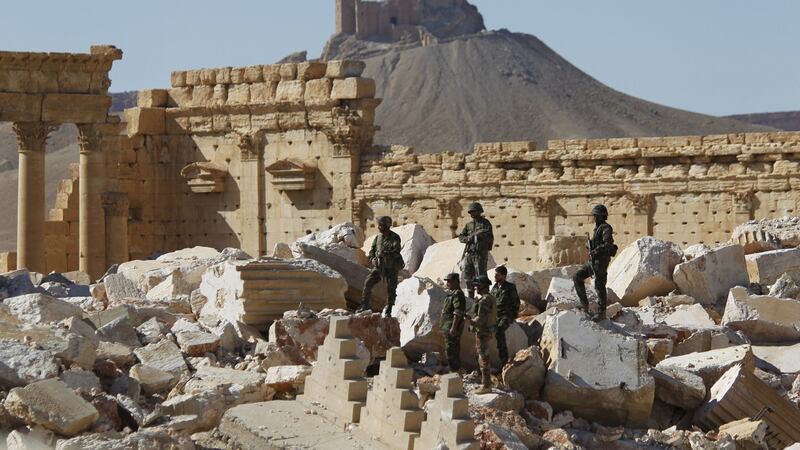Syrian troops have identified 45 bodies so far in a mass grave found in the city of Palmyra after it was recaptured from Islamic State (Isis), a military source said on Saturday.
Syrian government forces backed by heavy Russian air support drove Isis out of Palmyra last Sunday, inflicting what the army called a mortal blow to militants who had dynamited the city’s ancient temples.
The communal grave, on the north-eastern edge of Palmyra, is the only one found so far in the city by the Syrian forces, the source said. It held the bodies of both civilians and Syrian army members captured by Isis.

Meanwhile, Isis militants retreating from Palmyra are also said to have laid thousands of mines that they planned to set off simultaneously as the army moved in, a Syrian officer told Reuters in the ancient city after its recapture from the jihadist fighters.
Syrian state news agency Sana said on Friday the grave contained many women and children and some of the bodies had been beheaded.
In May last year, as Isis took control of Palmyra, the hard-line Islamist militants were reported by Syrian state media to have killed at least 400 people in the first four days of control.
The Syrian Observatory for Human Rights, which monitors the five-year-old Syrian conflict through a network of sources on the ground, said Isis had killed a number of people at an earlier time and buried them on the outskirts of the city.
The Observatory reported on Saturday that fighting between Syrian forces and Isis around Qaryatain to the west of Palmyra. It also reported Russian and Syrian air strikes in the same area and to the east of Palmyra around the town of Sukhna.
Rigged with explosives
The officer quoted regarding the mines in Palmyra said main streets and side roads in the city had been rigged with explosives, some weighing up to 50kg. More than 3,000 had already been safely detonated, he claimed.
He did not say why the Isis fighters failed to set off the explosives before pulling out, but his assertion echoed comments from Syria’s antiquities chief, who said the militants intended to dynamite a greater area of the city’s 2,000-year-old ruins than they already had.
The officer, who is not named, said the bombs left behind were linked so they could go off together.
“All the government buildings are rigged in a network connected to the Daesh leadership headquarters,” he said, using an Arabic acronym for Isis. “The idea was that as we enter it would all go off at once, not just bomb by bomb. And there are a really huge number of bombs.”
Parts of Palmyra have been cleared, including the road from Homs. But Syrian soldiers - soon to be joined by Russian de-mining experts - are still working on defusing or detonating explosives.
“We cannot leave them there. We are dealing with 90 per cent of them by exploding them because they are buried firmly in the ground, cemented in the asphalt,” the officer said.
Civilians, most of whom fled before Syrian and allied forces began the offensive, cannot return until de-mining is complete.
Smoke could be seen rising from some parts of the modern, residential city of Palmyra, which lies next to the 2,000-year-old ruins, during a visit by journalists on Friday.
Traces of explosions
But few people were to be seen and no shops were open. Residential areas had been damaged and traces of explosions could be seen on the ground.
As well as the network of bombs, Isis left traces of their 10-month rule in Palmyra. Graffiti was evident on some of the ancient stones. “Remaining”, it read, part of the Isis motto of “remaining and expanding”.
On a stone among the remains of the Temple of Bel was scrawled: “No shooting without the permission of the Emir.”
A signpost on a road through the ruins, now bent at 90 degrees to the ground, tells travellers in the group’s trademark black and white colours to “Respect God”.
“When we show humility, God will deliver us,” the sign says, above a passage from the Koran which says: “God made you victorious at the (battle of) Badr when you were but a humble (force),” referring to a battle from the early Muslim era which the ultra-hardline group looks back to with reverence.
The ancient Roman amphitheatre, where Isis shot dead about 20 men as it took over the city last May, appears unscathed.
The Temple of Bel, an imposing monument before it was blown up last year, has been reduced to a couple of columns and a heap of rubble, although antiquities chief Maamoun Abdelkarim says it is not totally beyond repair.
Other structures blown up by Isis include Palmyra’s triumphal arch, three funerary towers and the temple of Baal Shamin. Before serious renovation can take place, officials say, the area needs to be made fully safe.
Russian military servicemen will help to start defusing mines in Palmyra in a few days, Russian news agencies reported on Saturday, citing the defence ministry.
The first batch of specialists has left Russian airbase Khmeimim in western Syria. The convoy, consisting of more than 20 vehicles, will be guarded by Mi-24 and Mi-28 helicopters.
The de-miners will deal with more than 180 hectares of territory, Russia’s defence ministry has said, citing initial estimates.
The aim is to clear the historic part of the ancient city as well as residential areas.
Reuters
